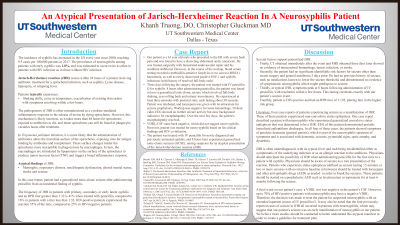Back

Clinical: General Topics
An atypical presentation of Jarisch-Herxheimer reaction in a neurosyphilis patient
Friday, March 31, 2023
12:00 PM East Coast USA Time


Khanh T. Truong, DO (he/him/his)
UT Southwestern Medical Center
Dallas, Texas, United States
Presenting Author(s)
Introduction: The Jarisch-Herxheimer reaction is a well-known phenomenon in the treatment of syphilis. Hours after administration of penicillin, up to 25% of all syphilis patients experience symptoms including fever, chills, and exacerbation of skin rashes, which resolve within a few hours. However, other atypical presentations of this reaction have been noted in the literature. To date, 4 patients have been reported who experienced non-convulsive seizures that were determined to be an atypical JHR. Only one has been reported as having generalized convulsive seizures. In each of these cases, the patients had a known diagnosis of neurosyphilis, and had previously demonstrated symptoms of neurological or cognitive decline. We present the case of a patient with an incidental diagnosis of syphilis and no known neurological deficits, who experienced a JHR following treatment with penicillin and having generalized convulsive seizures.
Case Study: 63 year old male who presented with severe back pain and found to have a dissecting abdominal aortic aneurysm. He was treated surgically. In the course of his workup, testing revealed newly discovered positive HIV-1 and syphilis infections. Patient was treated with IV penicillin G. Eight hours after, the patient was found to have a generalized tonic-clonic seizure which involved full-body shaking, eyes rolling back and urinary incontinence. Patient was given seizure prophylaxis medication. 24-hour video EEG showed no further seizure activity. Patient was treated for neurosyphilis based on his clinical findings and HIV co-infection.
Discussion: The patient was treated with IV penicillin, later experienced generalized tonic-clonic seizures (GCSE), raising suspicion for an atypical presentation of the Jarisch-Herxheimer reaction (JHR). Several factors support this conclusion. Firstly, imagings obtained showed no evidence of intra-cerebral hemorrhage, tumor, infection, or stroke. Secondly, patient had no significant identifiable risk factors for seizure, no previous history of seizure, no medications known to lower the seizure threshold, and demonstrated no evidence of symptomatic neurosyphilis. Thirdly, in typical JHR, symptoms timing correlate exactly with our patient’s seizure event.
JHR is often underdiagnosed, with its typical fever and rash being misidentified either as symptomatic of the underlying infection or as an allergic reaction to the antibiotic. Physicians should anticipate the possibility of JHR when administering penicillin for the first time to a patient with syphilis. Physicians should be aware of seizure as a rare presentation of the reaction. We believe more studies should be conducted to better understand this atypical manifest in order to create a guideline for treatment plan.
Case Study: 63 year old male who presented with severe back pain and found to have a dissecting abdominal aortic aneurysm. He was treated surgically. In the course of his workup, testing revealed newly discovered positive HIV-1 and syphilis infections. Patient was treated with IV penicillin G. Eight hours after, the patient was found to have a generalized tonic-clonic seizure which involved full-body shaking, eyes rolling back and urinary incontinence. Patient was given seizure prophylaxis medication. 24-hour video EEG showed no further seizure activity. Patient was treated for neurosyphilis based on his clinical findings and HIV co-infection.
Discussion: The patient was treated with IV penicillin, later experienced generalized tonic-clonic seizures (GCSE), raising suspicion for an atypical presentation of the Jarisch-Herxheimer reaction (JHR). Several factors support this conclusion. Firstly, imagings obtained showed no evidence of intra-cerebral hemorrhage, tumor, infection, or stroke. Secondly, patient had no significant identifiable risk factors for seizure, no previous history of seizure, no medications known to lower the seizure threshold, and demonstrated no evidence of symptomatic neurosyphilis. Thirdly, in typical JHR, symptoms timing correlate exactly with our patient’s seizure event.
JHR is often underdiagnosed, with its typical fever and rash being misidentified either as symptomatic of the underlying infection or as an allergic reaction to the antibiotic. Physicians should anticipate the possibility of JHR when administering penicillin for the first time to a patient with syphilis. Physicians should be aware of seizure as a rare presentation of the reaction. We believe more studies should be conducted to better understand this atypical manifest in order to create a guideline for treatment plan.
